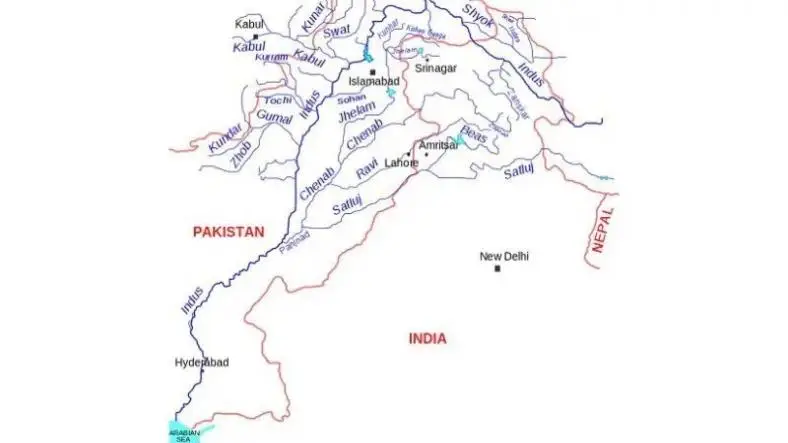Water is not just a natural resource for Pakistan—it is its lifeline. With over 90% of its water supply coming from a single river system, Pakistan is critically dependent on external sources. Agriculture, power generation, and daily life across the country rely on uninterrupted water flow, primarily from rivers originating in Indian-administered territory. In recent developments, however, the very foundation of this supply has come under threat.
Where Does Pakistan’s Water Come From?
1. The Indus River System
Pakistan’s surface water is almost entirely fed by the Indus River System, which originates from the Tibetan Plateau and flows through Indian-administered Jammu and Kashmir before entering Pakistan. Its major tributaries include the Jhelum, Chenab, Ravi, Beas, and Sutlej rivers.
This system was previously regulated under the Indus Waters Treaty (IWT) of 1960. Under this agreement:
- Pakistan was allocated the western rivers: Indus, Jhelum, and Chenab.
- India retained the eastern rivers: Ravi, Beas, and Sutlej.
Pakistan depended heavily on this framework, receiving over 80% of its surface water from rivers that originated in India.
2. Glacial Sources
The rivers are fed by meltwater from thousands of glaciers in the Himalayan and Karakoram ranges. These glaciers act as a seasonal reserve, but their stability is declining due to rising global temperatures. Rapid glacial melt and shifting snowfall patterns have introduced volatility to river flows, creating uncertainty around long-term water availability.
3. Rainfall and Groundwater
Rainfall plays a minor and inconsistent role. Groundwater has become a secondary source in Pakistan, but is being depleted at an unsustainable rate. In Punjab and Sindh, heavy extraction is leading to water table decline and increasing salinity—threatening both crop yields and drinking water.
India’s Role in Pakistan’s Water Security
Due to geography, India sits upstream of all major rivers that supply Pakistan. For decades, the Indus Waters Treaty ensured a predictable flow of water across the border. Despite multiple conflicts, the treaty endured and was seen as a cornerstone of stability—until 2025.
India built several run-of-the-river hydropower projects on rivers allocated to Pakistan, within treaty limits. These were contested but resolved through legal mechanisms or arbitration. Still, Pakistan’s reliance on Indian-administered rivers has remained absolute.
Google Ad 1
Post-2025 Shift: Pahalgam Attack, Operation Sindhoor and Treaty Suspension
On April 22, 2025, a terrorist attack occurred in the Baisaran valley near Pahalgam, Jammu and Kashmir. Terrorists, disguised in army fatigues, targeted a group of tourists, resulting in the deaths of 26 civilians, primarily Hindu tourists, and injuries to 17 others. The assailants reportedly asked victims to recite Islamic verses, executing those who failed to comply. The attackers fled the scene, and The Resistance Front (TRF) group officially claimed responsibility and four days later retracted their claim of responsibility. However, Indian authorities attributed the attack to Pakistan-based terrorist organizations, notably Lashkar-e-Taiba and Jaish-e-Mohammed.
In response to this incident, on April 23, 2025, the Government of India suspended the Indus Waters Treaty, citing ongoing security concerns and Pakistan’s role in supporting cross-border terrorism. This historic move marked the first time India suspended a major international water-sharing agreement, a decision that has led to severe repercussions for Pakistan.
And, on May 7, 2025, India launched Operation Sindoor, a series of missile strikes targeting what it identified as terrorist infrastructure in Pakistan and Pakistan-administered Kashmir. The operation aimed at nine locations associated with the aforementioned militant groups. India described the strikes as "focused, measured, and non-escalatory," asserting that no Pakistani military facilities were targeted.
Impact on Pakistan
The effects of the suspension were immediate:
- Water shortages hit Punjab and Sindh during the early irrigation season.
- Tarbela and Mangla dams saw drastic reductions in inflow, forcing cuts in electricity generation.
- Cities like Lahore and Karachi began experiencing low water pressure and disrupted supplies.
- The Kharif planting season suffered due to lack of water for rice and sugarcane crops.
- Food prices surged, and the government was forced to import grain and fuel, placing pressure on foreign reserves.
Pakistan, long reliant on upstream cooperation, now faced the reality of a restricted and uncertain water supply.
India Holds the Tap
With the treaty suspended, Pakistan no longer has a formal mechanism to ensure water delivery from rivers originating in India. Any flow into Pakistan now depends entirely on India's decisions—based on its domestic needs, security policy, and geopolitical considerations.
Calls for mediation or international intervention have gained no traction. There is no enforcement mechanism outside the treaty, and India currently holds full control over how much water reaches Pakistan. This new status quo has introduced a dangerous asymmetry—one in which Pakistan waits, but only India decides.
Conclusion: A National Wake-Up Call
Pakistan’s water crisis is no longer hypothetical. It is unfolding in real time. The suspension of the Indus Waters Treaty has revealed the extent of Pakistan’s dependency and vulnerability. Without upstream access and with no viable alternative in place, Pakistan’s future water supply now hinges on a neighbor that controls the source—and the tap.
This is a wake-up call: for self-reliance, for internal reform, and for urgent adaptation. The survival of Pakistan’s agriculture, cities, and energy sector depends not just on rainfall or reservoirs—but on the political will of a country beyond its borders.
Thanks for reading the article, read out articles for more such articles.














